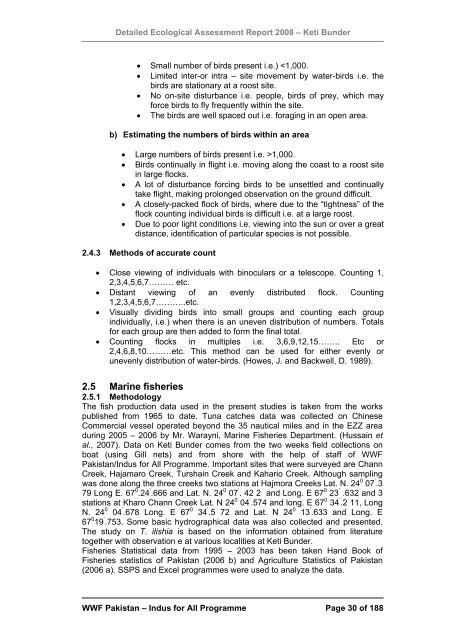Disclaimer note - WWF - Pakistan
Disclaimer note - WWF - Pakistan
Disclaimer note - WWF - Pakistan
You also want an ePaper? Increase the reach of your titles
YUMPU automatically turns print PDFs into web optimized ePapers that Google loves.
Detailed Ecological Assessment Report 2008 – Keti Bunder<br />
• Small number of birds present i.e.) 1,000.<br />
• Birds continually in flight i.e. moving along the coast to a roost site<br />
in large flocks.<br />
• A lot of disturbance forcing birds to be unsettled and continually<br />
take flight, making prolonged observation on the ground difficult.<br />
• A closely-packed flock of birds, where due to the “tightness” of the<br />
flock counting individual birds is difficult i.e. at a large roost.<br />
• Due to poor light conditions i.e. viewing into the sun or over a great<br />
distance, identification of particular species is not possible.<br />
2.4.3 Methods of accurate count<br />
• Close viewing of individuals with binoculars or a telescope. Counting 1,<br />
2,3,4,5,6,7……… etc.<br />
• Distant viewing of an evenly distributed flock. Counting<br />
1,2,3,4,5,6,7………..etc.<br />
• Visually dividing birds into small groups and counting each group<br />
individually, i.e.) when there is an uneven distribution of numbers. Totals<br />
for each group are then added to form the final total.<br />
• Counting flocks in multiples i.e. 3,6,9,12,15…….. Etc or<br />
2,4,6,8,10………etc. This method can be used for either evenly or<br />
unevenly distribution of water-birds. (Howes, J. and Backwell, D. 1989).<br />
2.5 Marine fisheries<br />
2.5.1 Methodology<br />
The fish production data used in the present studies is taken from the works<br />
published from 1965 to date. Tuna catches data was collected on Chinese<br />
Commercial vessel operated beyond the 35 nautical miles and in the EZZ area<br />
during 2005 – 2006 by Mr. Warayni, Marine Fisheries Department. (Hussain et<br />
al., 2007). Data on Keti Bunder comes from the two weeks field collections on<br />
boat (using Gill nets) and from shore with the help of staff of <strong>WWF</strong><br />
<strong>Pakistan</strong>/Indus for All Programme. Important sites that were surveyed are Chann<br />
Creek, Hajamaro Creek, Turshain Creek and Kahario Creek. Although sampling<br />
was done along the three creeks two stations at Hajmora Creeks Lat. N. 24 0 07 ’ .3<br />
79 Long E. 67 0 .24 ’ .666 and Lat. N. 24 0 07 ’ . 42 2 and Long. E 67 0 23 ’ .632 and 3<br />
stations at Kharo Chann Creek Lat. N 24 0 04 ’ .574 and long. E 67 0 34 ’ .2 11, Long<br />
N. 24 0 04 ’ .678 Long. E 67 0 34 ’ .5 72 and Lat. N 24 0 13 ’ .633 and Long. E<br />
67 0 19 ’ .753. Some basic hydrographical data was also collected and presented.<br />
The study on T. ilishia is based on the information obtained from literature<br />
together with observation e at various localities at Keti Bunder.<br />
Fisheries Statistical data from 1995 – 2003 has been taken Hand Book of<br />
Fisheries statistics of <strong>Pakistan</strong> (2006 b) and Agriculture Statistics of <strong>Pakistan</strong><br />
(2006 a). SSPS and Excel programmes were used to analyze the data.<br />
<strong>WWF</strong> <strong>Pakistan</strong> – Indus for All Programme Page 30 of 188

















